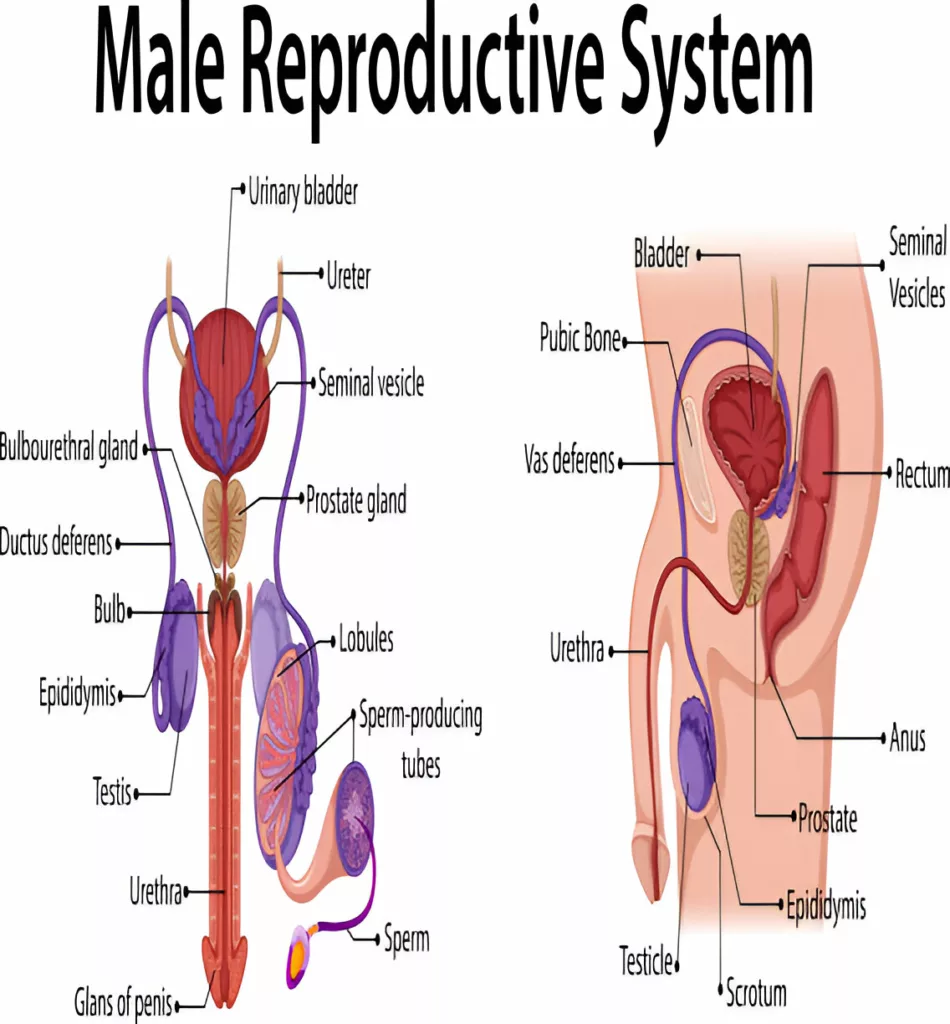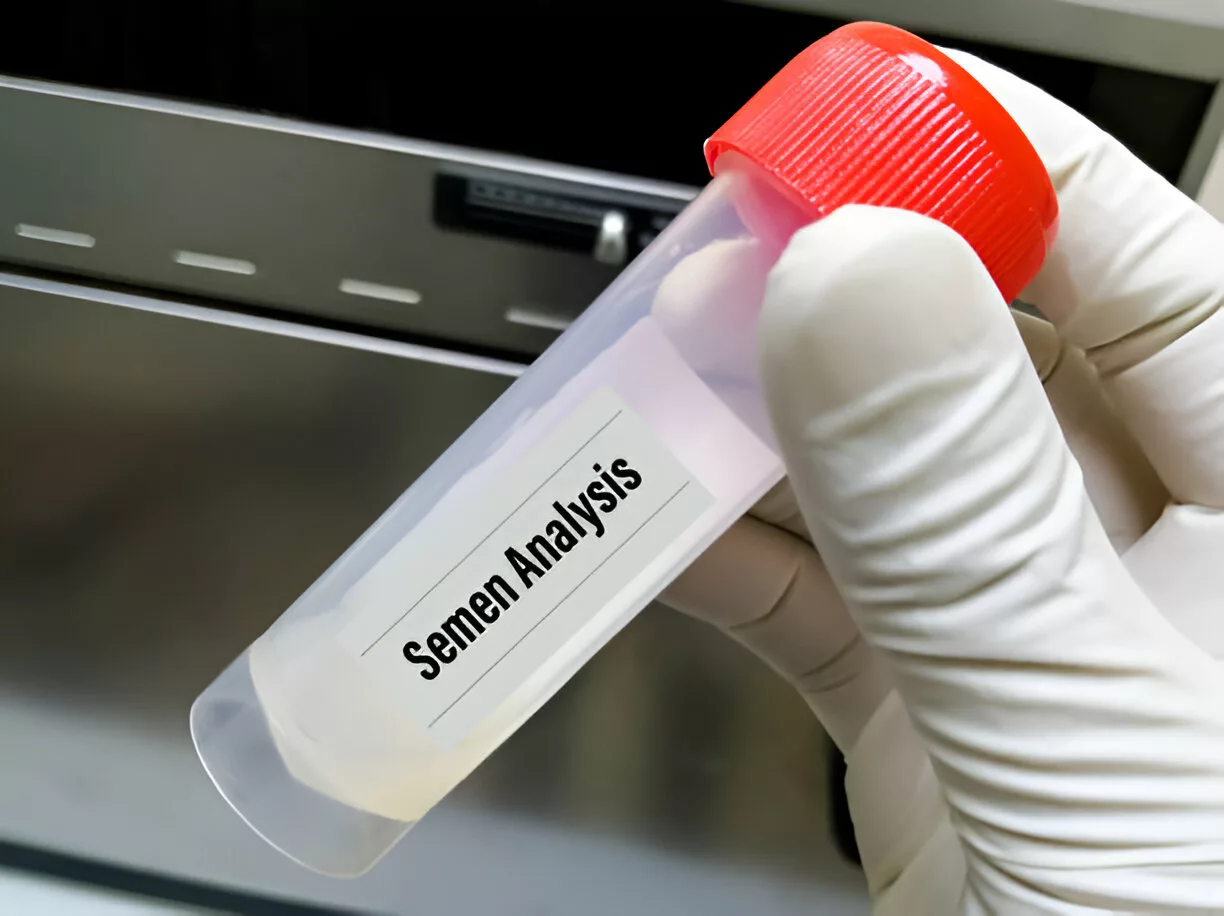Hematospermia, or the presence of blood in semen, may appear as pink, red, or brown discoloration during ejaculation. While it can be alarming, especially when noticed for the first time, it is usually benign and self-limiting in most cases. Many episodes resolve spontaneously without any treatment.1Rany Shamloul. Hematospermia: Diagnosis and management. Therapeutic Advances in Urology. 2013.
Semen is produced by the male reproductive tract, primarily involving the seminal vesicles, prostate gland, and vas deferens. Blood may mix with semen if any of these structures become inflamed, injured, infected, or affected by an underlying medical condition.2Kumar R, Hemal AK, Krishnani N. Hematospermia: A single-center experience. Indian Journal of Urology. 2001.
In young adult men, hematospermia is often idiopathic, meaning no identifiable cause is found. However, in older men, the likelihood of an underlying pathology, such as infection, inflammation, or even malignancy, increases and may warrant further evaluation..
Is Hematospermia Common or Rare?
People discuss hematospermia less frequently than its actual occurrence suggests. The condition occurs in most men at some point during their lives, but they avoid medical consultations because of embarrassment or fear. Research indicates hematospermia occurs in about 1 of every 5000 ejaculations, but the actual occurrence might be higher.3Leocádio DE, Stein RJ. Hematospermia: Etiology, evaluation, and management. International Brazilian Journal of Urology. 2021.
The condition occurs frequently in men below 40 years old, and it usually does not indicate a major problem. The medical evaluation becomes necessary for persistent cases, particularly when the patient is an older adult. The seriousness of the condition depends on the context, including whether the bleeding occurred after a vasectomy or sexual activity, or physical exertion.4Chung PH, Tiseo BC, et al. Idiopathic hematospermia: Results of conservative management. The Journal of Urology. 2005.
Causes of Hematospermia
Infections & Inflammation:
The most common culprits behind hematospermia are infections or inflammation in the reproductive or urinary tract.
- Prostatitis (inflammation of the prostate)
- Urethritis (inflammation of the urethra), and
- Epididymitis (inflammation of the epididymis) can lead to bleeding.
These conditions often come with pain, a burning sensation while urinating, or even fever.5Matsushita K, Ginsburg L, Lin DW. Urologic evaluation of hematospermia: Guidelines and management strategies. Urology. 2009.
Sexually transmitted infections (STIs) such as chlamydia and gonorrhea are triggers for this condition. The reproductive tract damage from these infections results in slight blood vessel ruptures that cause hematospermia during ejaculation.6National Institutes of Health (NIH), U.S. National Library of Medicine. Hematospermia: Causes and Diagnosis. MedlinePlus.2022.https://medlineplus.gov/ency/article/003132.htm

Trauma or Injury:
Any trauma to the groin area can cause minor bleeding.
- An accident
- Intense exercise
- Prolonged cycling
- Aggressive sexual activity
- Medical procedures, like a prostate biopsy or even a vigorous digital rectal exam.
These cases lead to temporary hematospermia that heals with tissue recovery. Medical procedures involving the prostate or urinary tract usually produce slight blood in semen that is normally not concerning.7American Urological Association (AUA). Hematospermia Information Guide for Patients. 2020. https://www.auanet.org/guidelines/hematospermia
Less Common but Serious Causes:
Tumors or Cancer
Doctors take male patients over 40 with hematospermia more seriously because of potential health risks. Prostate cancer, together with testicular cancer and other tumors located in the reproductive system, are hidden reasons for this condition. Early detection is crucial, which is why persistent hematospermia should never be ignored. Additional testing becomes necessary to diagnose cancer when it is suspected.8Emberton M, Fitzpatrick JM. The management of hematospermia. British Journal of Urology. 1997.
Systemic Disorders
Blood clotting disorders, together with liver disease and severe hypertension, create conditions that lead to hematospermia in patients. The body’s ability to regulate bleeding becomes affected by systemic diseases, which causes even slight irritations to result in visible blood.
Men undergoing treatment with blood thinners such as warfarin or aspirin experience an increased frequency of hematospermia. People who have hemophilia, together with other clotting disorders, face a higher risk of developing this condition.9Kearon C, et al. Antithrombotic Therapy for VTE Disease. CHEST Guidelines. 2016.
Hematospermia After Vasectomy:
The procedure known as vasectomy is a popular and secure method for male birth control. This procedure produces a rare side effect, which is hematospermia. This surgery involves cutting and sealing of vas deferens, which creates inflammation in the adjacent tissues. The semen of these patients can contain blood because of post-operative irritation or minor internal bleeding that usually lasts for several weeks after surgery.
The semen discoloration usually disappears during the initial few ejaculations. Most patients do not need to worry because the condition resolves through healing, but persistent severe pain or prolonged duration exceeding one month requires medical evaluation.10Jung JH, Kim DS. Outcomes of vasectomy-related hematospermia. Urology Journal. 2012.
When to Worry After a Vasectomy: Contact your doctor when hematospermia persists after 4–6 weeks post-vasectomy or when it presents with symptoms like fever along with intense pain or swelling, and signs of infection. Treatment may be necessary for cases involving infection or hematoma development.
Symptoms of Hematospermia
Hematospermia causes blood to appear in the semen, which is its most prominent indicator. The semen may display streaks of red, pink, or a brownish hue based on the age of the blood. The amount of blood ranges from unnoticeable to extremely visible in the semen. Even minimal blood presence within semen will turn most of the fluid reddish.
Men experience hematospermia either as a single occurrence or they see it repeatedly in multiple ejaculations. Most men show no additional symptoms. The presence of blood in semen can be associated with the formation of clots that may make the semen appear thicker and develop a jelly-like texture.
Associated Symptoms to Watch For
Pain:
The presence of pain during ejaculation or urination or a dull ache in the lower back, groin, or testicles indicates a possible underlying condition such as prostatitis or epididymitis. Your body sends pain signals as a warning that something’s wrong.11Salonia A, et al. Painful ejaculation. The Journal of Sexual Medicine. 2009.
When the prostate becomes inflamed or swollen, it may cause bowel movements discomfort which should prompt you to consult your healthcare provider.
Urinary Symptoms:
The presence of blood in semen sometimes occurs with urinary symptoms that include painful urination and difficulty in urination, as well as increased frequency. These signs of prostate or urinary tract infections become more apparent when accompanied by fever and chills.
Cloudy urine, foul-smelling discharge, or urgency to urinate are all clues that the issue might be infectious.
Erectile or Ejaculation Issues:
Hematospermia leads some men to reduced ejaculation power alongside post-ejaculatory discomfort and erectile dysfunction symptoms. These issues can be physical or psychological.
You should seek additional medical tests if these ongoing issues start to impact your daily life or relationships.
Diagnosis of Hematospermia
Men generally avoid consulting doctors when it comes to their genital health issues. Seeking medical advice for hematospermia problems will both reduce your stress and help prevent undetected severe conditions.
A single episode of hematospermia with no other symptoms does not typically require urgent medical attention. Men older than 40 with recurrent episodes should take it as a serious medical indicator. A doctor’s appointment becomes necessary if you experience pain alongside urinary symptoms and prostate or testicular cancer history in your family. Your doctor will begin by gathering all your medical history details, followed by a physical examination, including a digital rectal prostate assessment.
Urinalysis & Semen Analysis:
A urinalysis test identifies infections, blood, and other urinary irregularities. Semen analysis tests for red or white blood cells and infection markers, as well as other abnormal components. The discovery of an infection requires cultures to determine which bacterial strain is present.12Trinchieri A, et al. Hematospermia: Diagnosis and Treatment. Archivio Italiano di Urologia e Andrologia. 2009.
These tests are the starting point for figuring out if the issue is infectious, inflammatory, or possibly something more serious.

Imaging (Ultrasound, MRI):
When initial tests fail, imaging examinations become the next step. A transrectal ultrasound (TRUS) provides prostate, seminal vesicles, and ejaculatory ducts to detect cysts, inflammation, and blockages.13Bhargava P, et al. Role of transrectal ultrasound in the evaluation of hematospermia. British Journal of Radiology. 1993.
The doctor may order an MRI scan when needed to obtain detailed images, particularly when tumor suspicions arise. MRI produces superior images of soft tissues, which proves valuable for detecting abnormalities that other imaging tests cannot reveal.
Cystoscopy & Blood Tests:
The process of cystoscopy involves inserting a thin camera tube through the urethra for direct visualization of the bladder and urinary tract. The procedure provides better visualization of structural problems and tumors, as well as bleeding sources that other diagnostic methods fail to detect.
The blood tests analyze prostate-specific antigen (PSA) levels together with complete blood counts and clotting profiles to determine if bleeding disorders exist.
Hematospermia Treatments
Men who experience only occasional bleeding without pain do not need any medical intervention. The condition tends to heal by itself within a few weeks without intervention.
Young men who have no risk factors typically follow a “watch-and-wait” strategy. When patients avoid activities such as cycling and heavy lifting, and rough sexual activities, the healing process will be faster.
A combination of hydration and dietary balance with stress reduction helps your body heal naturally.
Antibiotics for Infections:
Antibiotics serve as the standard treatment for infections that cause hematospermia, including prostatitis and urethritis, and STIs. The duration of antibiotic treatment depends on the bacteria involved, but most prescriptions last between seven to thirty days.
The complete treatment remains important regardless of early symptom resolution because stopping early may lead to increased bacterial resistance. Infection recurrence becomes more severe when patients stop their antibiotic treatment prematurely.
When STIs affect your partner, they need to receive treatment as well, so maintain open communication channels.
Surgery or Biopsy in Severe Cases:
Rare cases of hematospermia caused by tumors, cysts, or structural abnormalities may require surgical intervention. Prostate cancer screening requires biopsies for older men and those with elevated PSA levels.
The treatment of a blocked ejaculatory duct requires a surgical procedure known as TURED (Transurethral Resection of the Ejaculatory Ducts).14Jarow JP. Transurethral resection of the ejaculatory ducts (TURED): Indications and outcomes. Fertility and Sterility. 1994.
These procedures are performed by urologists and have proven to be safe while effectively treating the condition.
Natural & At-Home Remedies:
Natural remedies work together with medical treatment. Although they cannot substitute for it but they can support the healing process:
- Internal inflammation can be reduced through the consumption of foods that have anti-inflammatory properties, such as leafy greens, berries, fatty fish, and nuts.
- Your system will experience less stress when you minimize your consumption of alcohol and caffeine, together with processed foods.15Kristal AR, et al. Diet, supplements, and prostate health: Current evidence. The Prostate. 2010.
- Better reproductive health emerges from proper rest, together with regular exercise and stress management through meditation or hobbies.
- Some men experience prostate health benefits from taking zinc or vitamin C supplements, as these substances promote prostate wellness.
- Doctors need to approve the use of herbal remedies such as saw palmetto and pygeum before patients can try them for prostate support.
- Drinking enough water plays an essential role in clearing toxins from the body and maintaining urinary tract wellness. Your daily fluid intake should reach at least 8 glasses unless your physician advises otherwise.
Is Hematospermia Dangerous?
Most cases of hematospermia do not pose any danger to men. Mostly, this condition exists as harmless and temporary issues. But it presents itself as a warning sign for more serious health problems. The risk factors that make hematospermia concerning are age above 40, persistent bleeding, urinary complications, or a testicular and prostate cancer background.
The presence of repeated episodes of hematospermia along with weight loss, bone pain, and systemic symptoms like night sweats indicates possible prostate or testicular malignancy. The situation requires consulting with a urologist.
You should be cautious if you take blood thinners or suffer from bleeding disorders. People with poor blood clotting need thorough examination because hematospermia presents itself as a symptom of this condition.
When is it a Medical Emergency?
The hematospermia typically does not require urgent medical intervention. Medical care becomes urgent in specific situations that present these warning signs:
- Intense or sudden testicular pain
- High fever and chills (possible infection)
- Inability to urinate
- Swelling in the scrotum or perineum
- Noticeable clots or large volumes of blood
Contact your healthcare provider immediately when you experience any of these symptoms along with blood in your semen.
Is It Contagious If Caused by Infection?
The presence of sexually transmitted infections as a cause of hematospermia leads to transmission of the infection rather than the blood itself. You should inform your partner about any STI diagnosis while maintaining protected sex.
Living with Hematospermia
The appearance of blood in semen leads many men to develop anxiety, feelings of embarrassment, and shame about their sexual health, together with concerns regarding their masculinity and fertility. Some men choose to stop having sex while creating emotional distance with their partners because of their fear.
These responses are normal but shouldn’t be ignored. The stress and anxiety about hematospermia tend to trigger performance anxiety and depression, which negatively impact both mental and physical wellness.
Talk about it. Whether it’s with your doctor, therapist, or a trusted partner. Remember, you’re not alone, and this condition is more common than it seems.
Talking to Your Partner:
Hematospermia discussions with partners become challenging because people worry about how their partners will react. Open communication between partners helps sustain trust as well as intimacy within their relationship.
You should inform your medical situation and doctor’s assessment to your partner while mentioning that most cases are non-threatening. The person requires confirmation that the condition is not a sexually transmitted infection or any form of contagious disease (which it typically is not).
Prevention of Hematospermia
The simplest way to prevent hematospermia is by practicing safe sex. Sexual practices must include STI prevention through condoms and periodic testing. The main source of reproductive tract inflammation, which leads to semen blood, comes from sexually transmitted infections.
The practice of safe sex protects you from injuries that occur during prolonged or excessive sexual encounters. If you develop hematospermia after vigorous sexual activity, you should decrease your sexual activities until your body recovers.
You should inform your sexual partners about ejaculation discomfort or changes in the same way you would handle any other health matter, because proactive steps will yield positive results.
Is Hematospermia Linked to Infertility?
Generally, no. Most cases of hematospermia do not affect fertility unless severe problems, such as duct blockages or infections, cause damage to reproductive tissues. Consult a doctor about conception while experiencing semen blood for an extensive evaluation.
Conclusion
The presence of blood in semen brings discomfort, although it does not mean you have a serious medical issue. The majority of patients experience hematospermia as a short-term condition stemming from infection, inflammation, or physical strain. A medical evaluation becomes necessary when symptoms continue or appear alongside other signs of illness.
The proper identification of causes, along with early detection of warning signs and proper testing, are essential steps for managing this condition. The majority of conditions can be effectively treated by medical professionals alongside the support of family members to help you regain your normal state.
Refrences
- 1Rany Shamloul. Hematospermia: Diagnosis and management. Therapeutic Advances in Urology. 2013.
- 2Kumar R, Hemal AK, Krishnani N. Hematospermia: A single-center experience. Indian Journal of Urology. 2001.
- 3Leocádio DE, Stein RJ. Hematospermia: Etiology, evaluation, and management. International Brazilian Journal of Urology. 2021.
- 4Chung PH, Tiseo BC, et al. Idiopathic hematospermia: Results of conservative management. The Journal of Urology. 2005.
- 5Matsushita K, Ginsburg L, Lin DW. Urologic evaluation of hematospermia: Guidelines and management strategies. Urology. 2009.
- 6National Institutes of Health (NIH), U.S. National Library of Medicine. Hematospermia: Causes and Diagnosis. MedlinePlus.2022.https://medlineplus.gov/ency/article/003132.htm
- 7American Urological Association (AUA). Hematospermia Information Guide for Patients. 2020. https://www.auanet.org/guidelines/hematospermia
- 8Emberton M, Fitzpatrick JM. The management of hematospermia. British Journal of Urology. 1997.
- 9Kearon C, et al. Antithrombotic Therapy for VTE Disease. CHEST Guidelines. 2016.
- 10Jung JH, Kim DS. Outcomes of vasectomy-related hematospermia. Urology Journal. 2012.
- 11Salonia A, et al. Painful ejaculation. The Journal of Sexual Medicine. 2009.
- 12Trinchieri A, et al. Hematospermia: Diagnosis and Treatment. Archivio Italiano di Urologia e Andrologia. 2009.
- 13Bhargava P, et al. Role of transrectal ultrasound in the evaluation of hematospermia. British Journal of Radiology. 1993.
- 14Jarow JP. Transurethral resection of the ejaculatory ducts (TURED): Indications and outcomes. Fertility and Sterility. 1994.
- 15Kristal AR, et al. Diet, supplements, and prostate health: Current evidence. The Prostate. 2010.





